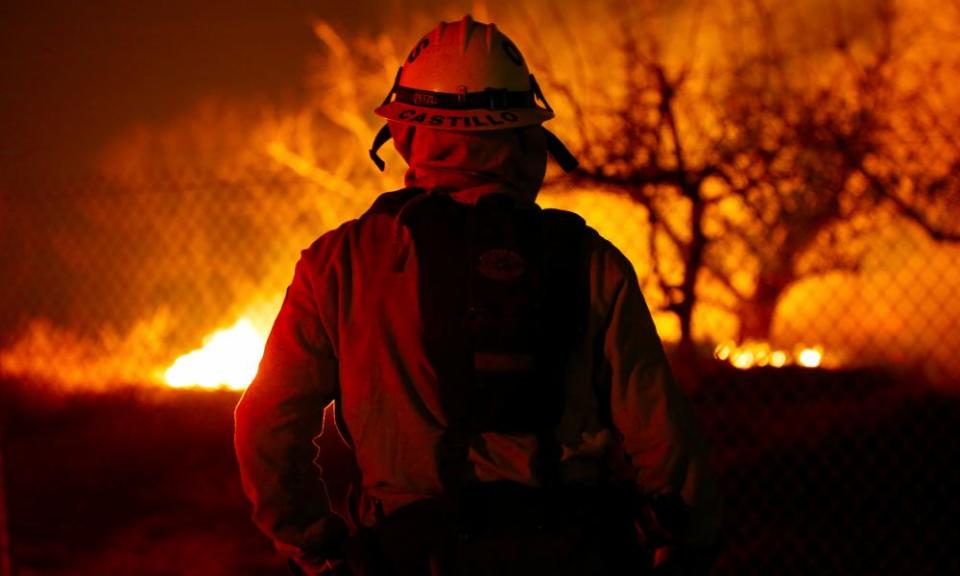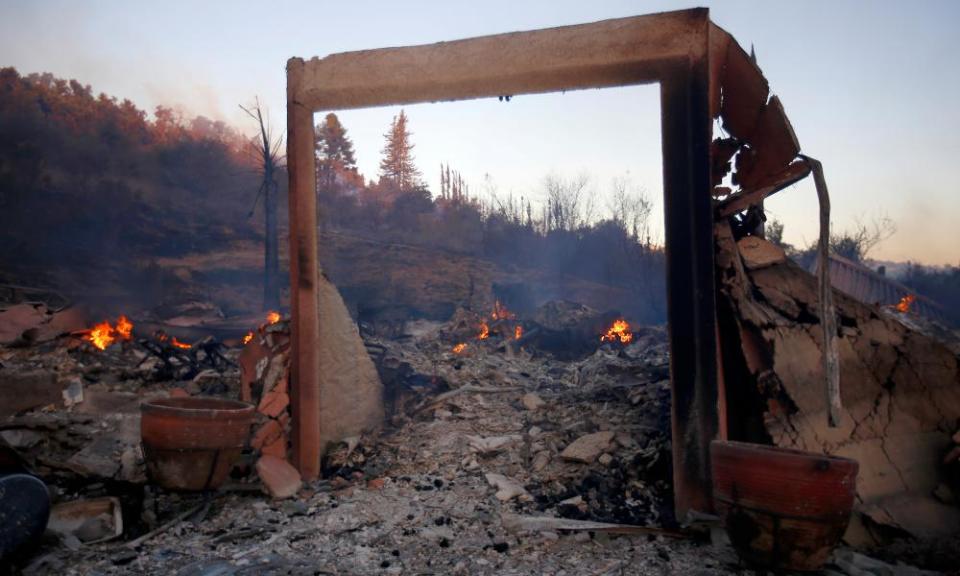California governor scans wildfire damage and blasts Trump for Paris climate pullout
Jerry Brown says president’s decision could lead to more devastating events
Firefighters continue to battle fires that have torched hundreds of homes

California governor Jerry Brown on Saturday saw for himself the “existential consequences” of huge and deadly wildfires in the state.
He did so having told network TV that Donald Trump did not appreciate that actions such as withdrawing the US from the Paris climate deal might contribute to more such devastating events.
Firefighters continued to battle six wind-whipped blazes that authorities said on Sunday have destroyed more than 1,000 homes and other buildings. The fires have also forced more than 200,000 people to flee and choked the air across much of the region.
Forecasters predicted wind gusts to become more intense by Saturday night, challenging the 8,700 firefighters who have been battling the blazes for five days.
Brown surveyed damage from the Thomas Fire and met emergency management officials and residents.
“This is the new normal,” he said. “We’re about ready to have firefighting at Christmas. This is very odd and unusual.”
Speaking to CBS 60 Minutes in an interview scheduled to be broadcast on Sunday night, the governor said Trump was wrong to withdraw the US from the Paris climate agreement and misguided for calling it a bad deal for America.
“That’s a preposterous idea, not even a shred of truth in that statement,” he said. “I don’t think President Trump has a fear of the Lord, the fear of the wrath of God, which leads one to more humility, and this is such a reckless disregard for the truth and for the existential consequences that can be unleashed.”
The Thomas fire is the largest of six that have scorched southern California this week, prompting Brown to declare a state of emergency. From Ventura County to San Diego County, fires have destroyed more than 500 buildings.
One human death has been blamed on the Ventura blaze: that of a 70-year-old woman who crashed her car while evacuating.
A 500-stall stable for thoroughbred race horses at San Luis Rey Downs training site burned late on Thursday, the Los Angeles Times reported.
An estimated 25 to 30 horses died, in addition to 29 horses killed in LA earlier in the week. A trainer suffered second- and third-degree burns over half her body trying to rescue horses, the newspaper said. She was airlifted to a San Diego hospital and placed in a medically induced coma.
The fires have put property worth billions of dollars at risk after wildfires in the northern part of the state in October resulted in insured losses of more than $9bn. Those fires, concentrated in wine country, killed 43 people.
Firefighters were on high alert for dangerous fire potential even before the first blazes broke out. On 1 December, they began planning for extreme winds forecast in the week ahead.

Ken Pimlott, chief of the California Department of Forestry and Fire Protection, said authorities were prepared for destruction on the level of 2003 and 2007 firestorms in southern California and possibly those in northern California this year. By Monday, they had moved fire crews from the northern part of the state as reinforcements and marshaled engines, bulldozers and aircraft.
On Tuesday they brought in more helicopters from the national guard and “every last plane we could find in the nation,” said Thom Porter, southern chief of the California Department of Forestry and Fire Protection.
The military provided C-130 planes for water drops, said Mark Ghilarducci, director of the California Office of Emergency Services. More than 290 fire engines came from Montana, Utah, New Mexico, Idaho, Arizona, Oregon and Nevada.
But once flames met ferocious winds, crews were largely powerless to stop them. Even fire-attacking aircraft were helpless while being grounded at times because of night, high winds or smoke.
Winds forecast for later on Saturday “potentially put the fires that are currently burning at risk of spreading”, said Lynne Tolmachoff, spokeswoman for California Department of Forestry and Fire Protection.
On Friday, Trump issued an emergency declaration allowing counties affected by the wildfires to receive federal assistance.

